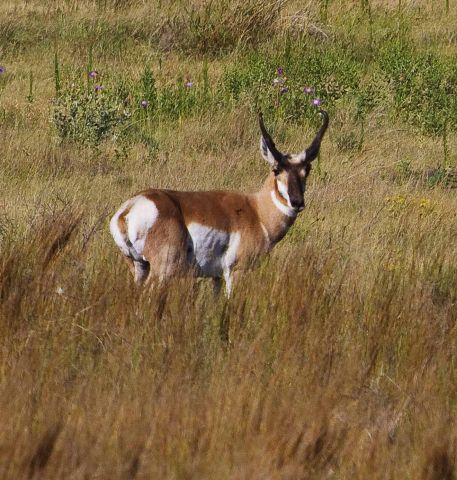
Panhandle Pronghorns: How Do Crops Influence Them?

Pronghorns currently are found in about 27 counties in the Texas Panhandle. Although the fleet-footed animal called an “antelope” by many folks has long been an iconic resident of the plains, we know very little about the movements, spatial distribution, and habitat use of pronghorns in the Panhandle. Once a vast shortgrass prairie that seemed unending to travelers in the 18th century, the Panhandle landscape today is a patchwork of prairie, crops, and small towns. Much of the cropland is irrigated out of the Ogallala aquifer, an incredible and extensive underground lake that has been tapped by farmers and urbanites alike for decades.
Agricultural crops, particularly when they are irrigated, provide abundant, high-quality forage. Although one typically does not think of farmland as habitat for pronghorns, presence of high-quality forage makes crops highly attractive to them. In fact, crops are so attractive that some Panhandle farmers are concerned about just how much the critters are eating. Caroline Ward, one of our graduate students, recently completed her master’s thesis on radio-collared pronghorns. Caroline found that near Pampa, Texas, more than a quarter of radio-collar relocations during April to October 2014 occurred in agricultural crops. This shows that much of the time pronghorns spent in agricultural crops.
We are initiating a new research project in January 2017 in collaboration with Texas Tech University and Texas Parks and Wildlife Department to determine how much use pronghorns make of agricultural crops in the Texas Panhandle. Texas Parks and Wildlife Department is providing funding for the project. We will use study areas near Dalhart and Pampa, Texas. We plan to place GPS collars on 32 pronghorns at each site, half of them male and half female. These collars have the capability of transmitting GPS locations to satellites. We will collect locations of each animal every couple of hours, which will give us an extensive record of where the animals are at all times of the day. We will track the animals for 2 years to determine their movement patterns with respect to agricultural crops, and to determine how much time they spend in cultivated areas. With the information we collect, we will be able to get a handle on how much use they make of different types of crops, and how dependent the pronghorn population is on availability of dryland and irrigated crops versus rangeland.
Researchers in Kansas and Colorado have found that pronghorns spend considerable time foraging in winter wheat fields. This was initially a cause of concern for farmers in the region. However, researchers found that pronghorns typically shift patterns of use from winter wheat fields to rangeland before winter wheat matures sufficiently to be damaged by them. Concerns among Texas landowners about crop damage might be partly alleviated if pronghorns use crops such as wheat and winter rye in early growth stages and then shift foraging activity to rangeland before the crops are susceptible to damage.
In addition to developing a better understanding of the use of crops by pronghorns, we will also examine how landscape features such as highways, ranch roads, fences, and water availability influence movements and behavior. Identifying landscape features that may constrain or act as barriers to pronghorn movements will aid wildlife biologists in managing landscapes to minimize the effects of habitat fragmentation on the species. Knowledge of areas where pronghorns aggregate and identification of the portions of the landscape most heavily used by pronghorns will assist in allocation of hunting permits and population monitoring since animals may be clumped in portions of their range.
Our study will help biologists develop a better idea of how future changes in the Panhandle may influence pronghorn populations. The Panhandle landscape will likely support more roads and fences in the future with development of infrastructure such as windfarms and power corridors. The Ogallala aquifer is being depleted, which may result in reduced crop production in the Texas Panhandle in the future. Our research will provide insight into how the presence of more human-imposed structures and reduced crop production may influence pronghorn populations in the future.
Note: Dr. Tim Fulbright, Dr. Randy DeYoung, Dr. David Hewitt and Dr. Humberto Perotto were recently awarded a sizeable grant by Texas Parks and Wildlife for their project entitled “Influence of Agricultural Production on Pronghorns in the Panhandle”. Because information regarding movements, spatial distribution, and habitat use of pronghorns in this region is lacking, they will work to determine the dynamics of pronghorn movement and habitat selection in the Texas Panhandle. Understanding the movements and habitat of pronghorns in relation to areas of agricultural production will help wildlife biologists in alleviating conflicts with agricultural producers.